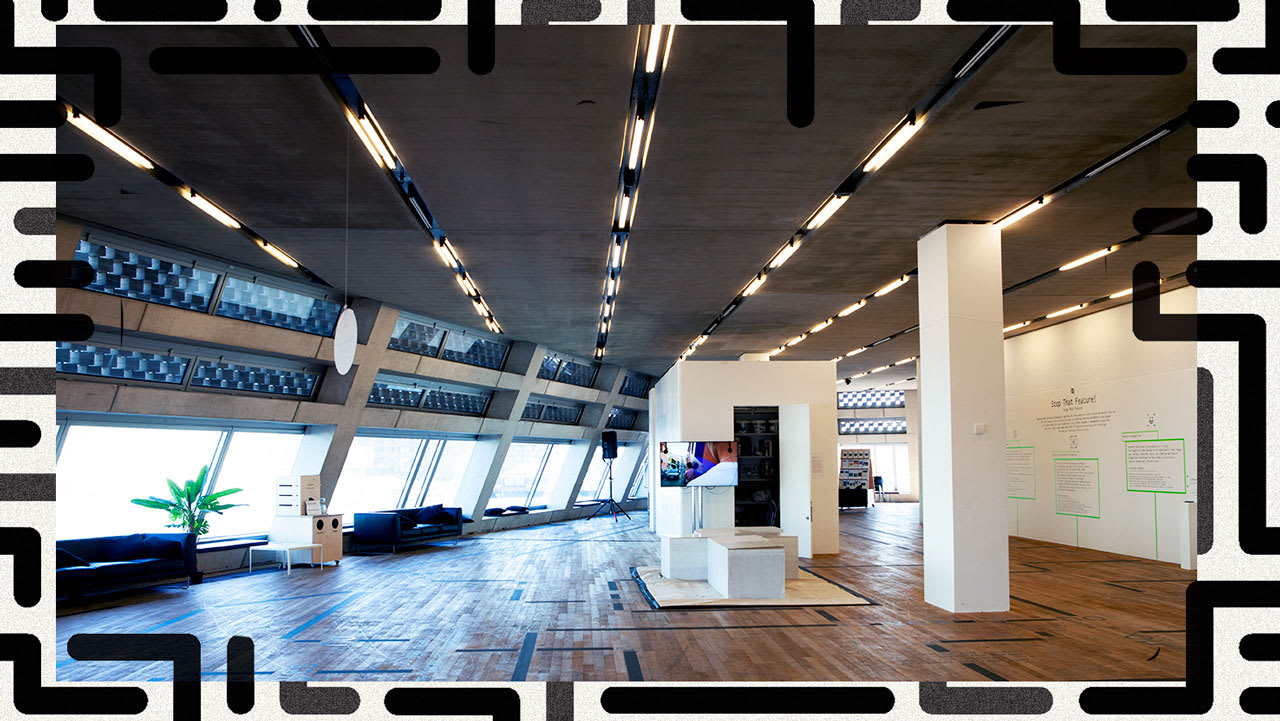
As we move around in online spaces, it can be difficult to keep track of how visible our actions and our conversations are to other people—and to the corporations that mine our data for profit. Because all of your online interactions happen through the same set of devices, it can be hard to keep track of when your communication is actually public.
But a new exhibition at the Tate Modern museum in London uses a simple metaphor to explain the sliding scale of privacy on different online platforms in a way everyone can understand: architecture.
For instance, the most public forums on the internet, like Twitter, resemble public squares, where crowds of people gather. Posts such as tweets are searchable and tied to your identity forever (unless you delete them), making them the most extreme form of public interaction online. But there are also semi-public places, like Facebook or Instagram, which require you to log in to access them. The exhibition argues that using Facebook is like chatting with a friend while sitting on a park bench—it might feel private, but there’s a definitely chance that someone could overhear you, and you may even run into someone you know (Facebook does provide a large amount of privacy settings so you can decide who exactly sees what you post, though many people don’t bother with them). While walking through the Tate’s space, the differences between how these types of platforms work becomes more visceral because you can actually sit on a park bench while learning about Facebook’s privacy.
By creating familiar physical spaces that correspond to the online platforms many of us know so well, the artists behind the exhibition hope to help people become more digitally literate. “When it comes to our online behavior, we have a hard time discerning how public something can be,” says Carmen Augilar y Wedge, a designer and co-founder of the studio Hyphen Labs, who created the exhibition with her co-founder Ece Tankal. “We have private conversations through very public channels and… we don’t know how that info is going to be used in the future.”
These public and semi-public digital spaces are everywhere online, and with them comes the risk of surveillance. Just like CCTV cameras often capture the movements of everyone moving through public squares and parks (and could potentially analyze them using facial recognition algorithms), so too do Facebook and Twitter track your conversations and interactions. Marketers and political groups can then data-mine your posts to determine which advertisements you see—which could be for products you might be interested in, or could be intended to manipulate the way you might vote.
But there are also semi-private and entirely private places that exist online. One is the group chat—which is like your living room (in the exhibition, visitors can sit in an actual living room, completely with couches and a coffee table). The only people allowed in are those you’ve invited, and your conversation stays among friends, especially if you used an encrypted chat service, like WhatsApp or iMessage. But even in the safety of the living room, there remains the threat of surveillance, with smart home devices’ microphones listening for a wake word and possibly recording random conversation in the process or forking snippets of your dialogue over to researchers.
“Lots of digital spaces are designed in a binary way—it’s private or it’s not,” says Caroline Sinders, a machine learning researcher and artist who collaborated on the exhibition with Hyphen Labs. “But that’s not the way we live our lives. We have a variety of social interaction that can’t be fit into those two buckets.”
One of the most private places online you can go is a direct message—and the exhibition compares this type of interaction to the bathroom (though the metaphor doesn’t quite work here: the loo is usually a place that you occupy alone). In the exhibition hall, there’s a chair set up within a circular curtain, complete with a toilet paper holder, to complete the illusion.
Even at this most private level, communication is still mediated by tech platforms. “Powerful systems gain power by embedding themselves in your everyday life,” Augilar y Wedge explains. “Technology has really encoded itself into all our types of relationships, which is why it’s become so powerful.”
Facebook, the giant of social networking, has decided that more private conversation—like you’d have in your living room, or one-on-one in your home—is the future of the company. Given the sheer number of scandals that the company has faced over data leaks and privacy violations, it’s a logical move that’s more in line with the direction that people are moving anyway. With the rise of misinformation and tech companies’ inability to effectively police harassment, the shiny veneer of many of the public and semi-public spaces on the internet has worn off.
Using these familiar architectural places as a metaphor helps highlight just how public most of our interactions are, even as we gravitated toward more private communication. Many of us spend large amounts of time in public and semi-public spaces in the real world—commuting, in the office, in a restaurant—perhaps just as much as we do in the privacy of our own homes. Comparatively, we spent very little time in that most private of places—the bathroom. Similarly, the vast amount of our time spent online is often public, even when it feels private. Browsing through websites on your computer, even if you don’t think you’re interacting with anyone, is an incredibly public act, with dozens of trackers reporting your every move to their corporate owners (unless you decide to use a private browser, like Tor).
Part of the challenge is that all of our online interactions, from the most public to the most private, can happen on the same device: a smartphone. But remembering which apps act like different types of architecture—from the public square to the living room—is a handy guide for keeping the spectrum of digital privacy straight.
read more at https://www.fastcompany.com by Katharine Schwab
Tech









